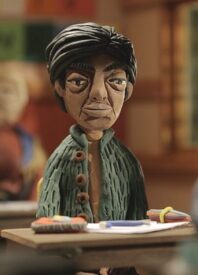
Dario Doria’s Vicenta is one of many animation documentaries out there. But this one stands out for mostly matching content with form. Much of the doc depicts the titular subject take multiple transit rides from the Argentine suburbs to La Plata. There, she takes her special needs daughter Laura for court and doctor’s appointments. The sound design makes it seem like the world is moving but it’s not. This is, for the most part, apt. One of Laura’s uncles, Luis, sexually assaults Laura, which causes her to be pregnant. The appointments, then, are for Laura to get an abortion, but sadly, allegedly Christian judges and an incompetent healthcare system stops her from getting one legally.
Vicenta is less animation and looks more like a series of still videos capturing Plasticine figures. A few key elements bring life to a film that may otherwise seem still. The first is the visual aspect. The Plasticine sculptures themselves have so much texture, especially on Vicenta’s face. Even in soft focus, it shows the decades of struggle that she lives through. And that’s before the worst thing to ever happen to her does. And the second element is Liliana Herrero’s narration, as she reads a script that sometimes uses the second person, addressing Vicenta. This use of the second person effectively makes the audience feel the weight of bureaucracy that Vicenta endures to get proper justice.
If it isn’t obvious now, Vicenta‘s documentary aspect comes from the fact that it recounts, in a novel way, a case that almost didn’t change history. The animation aspect may take it out of reality, but news footage pulls the story back onto the ground. It plays audio of real reporters recounting Catholic priests going to hospitals to remind them of the legal ramifications of going through with the abortion. What these priests are doing is nothing short of harassment to get what they want. Some of this, after repeat viewings, feel like the film is preaching to the choir. Nonetheless, it competently can get viewers’ blood boiling at the Catholic Church’s audacity.
Another nitpick against Vicenta is that it almost follows a three act structure that makes this feel more fictional than it should. It shows a ‘normal’ life, then disruption, then equilibrium. The film begins its third act by showing a semblance of that equilibrium. It shows, specifically, Laura watching cartoons again as if nothing happens. Thankfully sideswipes from that easy route, as it shows that Vicenta has one more fight in her. The film begins by revealing details about her early life, explaining her illiteracy. Against all odds, she gets an education. And I know everything else is on public record, but I won’t spoil the brave act that she does in the end.
Vicenta, a Hot Docs selection from 2021, is now on OVID.
- Rated: NR
- Genre: Animation, Documentary
- Directed by: Darío Doria
- Produced by: Felicitas Raffo
- Studio: CEPA Audiovisual

